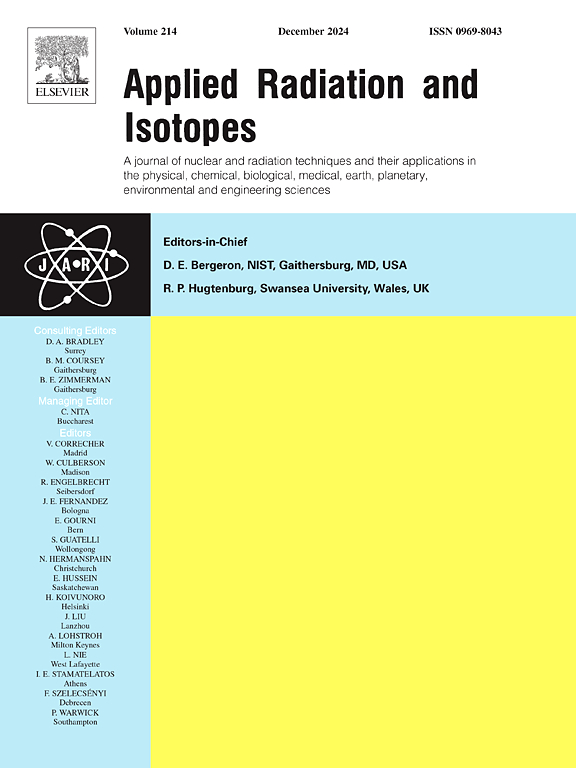The relationship of Cadmium, Lead, and Uranium with the geographical location of non-smoking Thalassemia individuals: A comparative study
IF 1.6
3区 工程技术
Q3 CHEMISTRY, INORGANIC & NUCLEAR
引用次数: 0
Abstract
Background and aims:
Thalassemia is a group of heterogeneous hemolytics. Anemia is characterized by autosomal recessive inheritance Due to impaired synthesis of hemoglobin (Hb). The most common types of Thalassemia are Thalassemia and beta-thalassemia, which are named for the hemoglobin chains they affect. Blood from Thalassemia patients differs from the blood of healthy human beings due to function abnormalities such as reduced hemoglobin synthesis, changed crimson blood cell architecture, and scientific indicators of anemia. Heavy metal (HM) toxicity has been described as a risk factor for the development of Thalassemia in women and men; its assessment can predict susceptibility to Thalassemia (Thal.) HM levels of Cadmium (Cd), Lead (Pb), and Uranium (U) were evaluated in non-smoking individuals from outside and inside the holy city of Najaf. Eighty-two females, aged (9–40) years, and forty controls (11–45) years, were recruited into this case-control study. As well as the possibility of a relationship between the disease and radiation through detection of blood Uranium levels.
Method:
The concentration values of the studied elements were determined in units (ppb) for Cadmium and lead after their digestion using flame atomic absorption spectrometry (FAAS). In contrast, uranium concentrations (ppb) were measured using a solid-state nuclear track detector (CR 39) by measuring the radon concentration.
Results:
The average standard deviation (SD) for (Cd) concentrations in the serum of the control group were higher (19.405 ± 1.117) ppb compared to the serum of Thalassemia individuals (1.570 ± 0.658)ppb, with high statistical significance (P 0.05), while (Pb) in the serum of the control group (32.051 ± 8.423) ppb and vice versa was the lowest compared to the serum of Thalassemia individuals, with high statistical significance. As for (U) concentrations, they were close between the two groups, respectively, and the -value was greater than 0.05. The ANOVA analysis between the concentrations of the studied elements was statistically significant. Cd was positively correlated with Pb (r = 0.204, P = 0.066). The relationship between Cd and U has been neglected (r = 9.011, P = 0.922). As for Pb and Cd, the correlation was positive and weak (r = 0.204, P = 0.066).
Conclusion:
The serum concentrations of the studied elements in Thalassemia individuals outside the city of Najaf were higher than those of Thalassemia individuals inside the city of Najaf. The current study showed a difference in the mean differences in the concentrations of the studied elements between the Thalassemia group and the control group, and the location was important, as it was found that the concentrations were higher for the Thalassemia group outside the city of Najaf compared to the Thalassemia group inside the city.
求助全文
约1分钟内获得全文
求助全文
来源期刊

Applied Radiation and Isotopes
工程技术-核科学技术
CiteScore
3.00
自引率
12.50%
发文量
406
审稿时长
13.5 months
期刊介绍:
Applied Radiation and Isotopes provides a high quality medium for the publication of substantial, original and scientific and technological papers on the development and peaceful application of nuclear, radiation and radionuclide techniques in chemistry, physics, biochemistry, biology, medicine, security, engineering and in the earth, planetary and environmental sciences, all including dosimetry. Nuclear techniques are defined in the broadest sense and both experimental and theoretical papers are welcome. They include the development and use of α- and β-particles, X-rays and γ-rays, neutrons and other nuclear particles and radiations from all sources, including radionuclides, synchrotron sources, cyclotrons and reactors and from the natural environment.
The journal aims to publish papers with significance to an international audience, containing substantial novelty and scientific impact. The Editors reserve the rights to reject, with or without external review, papers that do not meet these criteria.
Papers dealing with radiation processing, i.e., where radiation is used to bring about a biological, chemical or physical change in a material, should be directed to our sister journal Radiation Physics and Chemistry.
 求助内容:
求助内容: 应助结果提醒方式:
应助结果提醒方式:


